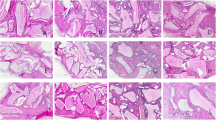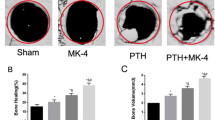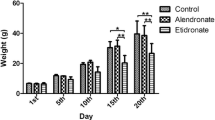Abstract.
The mechanisms that regulate the migration, proliferation and differentiation of osteogenic cell populations in vivo are poorly understood. Elucidation of these mechanisms is essential for an understanding of the basic processes that determine mineralized connective tissue homeostasis and regeneration. Bisphosphonates are known to regulate bone metabolism, in part through effects on osteoclastic resorption. Given previous data from other in vitro and in vivo investigations, we considered that they could also affect the proliferation and differentiation of osteoblasts in vivo. We tested this hypothesis using a bisphosphonate (ethane-1-hydroxy-1,1-bisphosphonate, HEBP, etidronate) and a calvarial wound model in which osteogenic differentiation and bone formation are coordinately induced by the wounding stimulus. Wounds through the calvarial bone were created in 20 male Wistar rats. After surgery, animals were treated every day for 1 or 2 weeks with HEBP or saline (controls) and five rats in each group were killed at 1 or 2 weeks following surgery. Cellular proliferation and clonal growth were assessed by 3H-thymidine labeling 1 h before death followed by radioautography. Cellular differentiation of osteogenic cell populations was determined by immunohistochemical staining for osteopontin and bone sialoprotein. Von Kossa and toluidine blue staining were used for the assessment of mineralization and osteoid formation, and for morphometric analysis of wound closure. At 1 and 2 weeks after surgery HEBP promoted wound closure (>twofold greater than controls, P<0.001) and mineralized/osteoid tissue formation in the bony compartment of the wound (>50% higher than saline controls, P<0.05). In HEBP-treated animals there was a >50% increase in intracellular staining for osteopontin in the endosteum-lined spaces adjacent to the wound (P<0.05) and increased staining for osteopontin in the nascent bone at the wound margin (>50% greater than controls, P<0.05). However, there were reduced cell counts and labeling indices at stromal precursor sites (65% reduction compared to controls; P<0.01). As HEBP increased osteopontin expression and osteoid/mineralized tissue formation but reduced the proliferation of precursor cells, we conclude that in addition to blockade of bone resorption and mineralization, this drug, at doses which also reversibly inhibit mineralization, may promote osteoblast differentiation as well.
Similar content being viewed by others
Author information
Authors and Affiliations
Additional information
Electronic Publication
Rights and permissions
About this article
Cite this article
D'Aoust, P., McCulloch, C., Tenenbaum, H. et al. Etidronate (HEBP) promotes osteoblast differentiation and wound closure in rat calvaria. Cell Tissue Res 302, 353–363 (2000). https://doi.org/10.1007/s004419900165
Received:
Accepted:
Issue Date:
DOI: https://doi.org/10.1007/s004419900165




